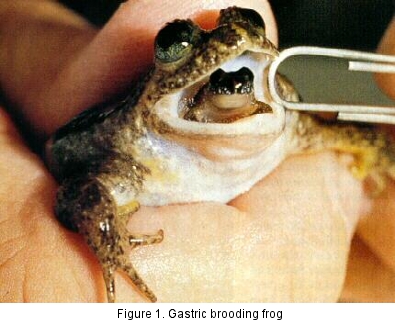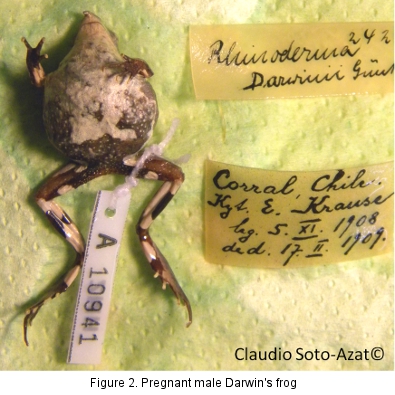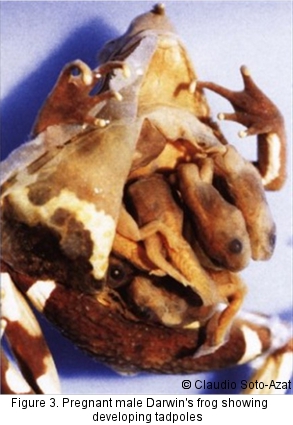The unique early development of Darwin’s frogs
By EDGE Fellow Claudio Soto-Azat
Darwin’s frogs are two species of endemic anurans: the Northern Darwin’s frog (Rhinoderma rufum) and the Southern Darwin’s frog (R. darwinii), which inhabits the temperate forest of central and south Chile, and an adjacent area in Argentina. Both species are of special conservation concern, while R. rufum has not been recorded since 1980, R. darwinii has undergone a rapid decline in its populations, therefore suffering a drastic reduction in their historical natural range. Rhinoderma darwinii was discovered for the western world in February 1835, near the city of Valdivia in Southern Chile, by Charles Darwin himself, during his epic expedition around the world in the HMS Beagle. French zoologists André Marie Constant Duméril and his assistant Gabriel Bibron, revised this collected material, and gave its scientific name in his honour.
Darwin’s frogs have a curious and extreme form of parental care, which makes them unique within the class Amphibia. After taking care of the fertilized eggs, males of both species ingest late developed eggs, incorporating them within a specialized structure, the vocal sac, where most or all larval life develops. This structure consists in a dilation of the proximal digestive tract, therefore communicated with the mouth cavity. These two species are the only living mouth-brooding frogs on earth. There were two species of Australian gastric–brooding frogs (Rheobatrachus silus and R. vitellinus), which became extinct in the mid-1980’s, soon after their discoveries.
Figure 1. Female “pregnant” Northern gastric–brooding frog (R. silus) from the tropical forests of Australia. Last captive specimen died in 1983.

Tadpoles of R. darwinii, live their entire larval life within the sac. Fathers supply the babies with a special secretion which contains all nutrients and requirements they need. In the field, you might notice tadpoles developing within the vocal sac as they frequently move inside, giving the appearance of tadpoles swimming in a “small environment” and even there is a chance to broadly count them! It has been described that males may brood from one to 19 tadpoles, giving sometimes a “Jabba the hut” appearance (have you ever seen Star Wars?) to pregnant males. Difficult to imagine, metamorphosis takes place at this site, and after a period of approximately six to eight weeks, pregnant males regurgitate small replicas of the adults. In R. rufum, larval life within the sac only covers the first larval stages, time when fathers regurgitate tadpoles near shallow streams, and some weeks later metamorphosis take place.
Figure 2. Museum specimens of male pregnant Darwin’s frogs (R. darwinii). Note dissected vocal sac and number of developing tadpoles.
The explanation of how this bizarre behaviour arouse, remains poorly understood, and is matter of current research. Something similar only occurs in the animal kingdom among sygnathid fish (seahorses), where males also get a “pregnant” appearance during incubation of eggs within the brood pouch.
In order to share unpublished original video images showing this amazing behaviour, I developed a video clip with a series of pregnant male Darwin’s frogs, footage obtained during the last three years of intensive research on different locations of south Chile. You will notice Darwin’s frogs exhibit a “playing dead” behaviour to avoid predation. Once they feel in danger, they turn upside down and may remain on that position from a few seconds to even 30 min. Note also the “peeeep”-like calls they produce to communicate, and finally the sometimes bad weather conditions. Enjoy!
Video. Selection of male pregnant Darwin’s frogs (R. darwinii) showing tadpole movements within the vocal sac.
If you would like to support EDGE Fellows such as Claudio and their research and conservation of EDGE species you can can find out more on our Support EDGE webpage.

